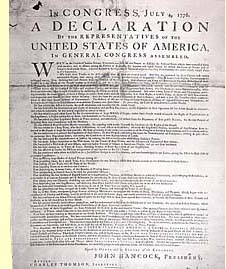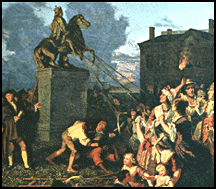

Drafting
the Declaration of Independence
![]()
![]()
![]()
![]()
The Declaration of Independence, approved by the Continental Congress on July 4, 1776, is a statement of the principles that 2 days earlier had led Congress to vote for the independence of the American colonies from Great Britain. It was designed to influence public opinion, both at home and abroad, especially in France, to which the United States looked for military support.
The drafting of
the document was entrusted to a committee consisting of John Adams, Benjamin
Franklin, Thomas Jefferson, Roger Sherman,
and Robert R. Livingston. Because of Jefferson's reputation as a literary
craftsman, the committee assigned the task to him, and with minor exceptions
it is his work. Jefferson drew upon a long oppositionist tradition
in Britain, as well as the
English and French
Enlightenments, as sources for his ideas; his language and the structure
of his argument, however, most closely parallel the natural-rights theories
of John Locke. In justifying England's Glorious Revolution of 1688, Locke
had advanced the contract theory of government, arguing that all "just"
governments are founded on consent and are designed solely to protect people
in their inherent rights to life, liberty, and property. Radical proponents
of this theory had used it to justify civil disobedience whenever government
encroached on any of the specified rights; the more conservative Jefferson
held that resistance is justified only when a consistent course of policy
shows an unmistakable design to establish tyranny.

Signing
the Declaration of Independence - July 2, 1776
King George III bore the brunt of Jefferson's attack, although earlier protests had been directed at Parliament and the governing ministry. This focus was necessary for a contractual justification of independence, as the colonists had consistently maintained that their only contract was with the crown.
In one key respect
Jefferson used Natural Law instead of natural-rights theory, substituting
"the pursuit of happiness" for "property" in the trinity of inalienable
rights. In this change, derived from the Swiss legal philosopher Emerich
de Vattel, he emphasized public duty rather than (as the language seems
to indicate) personal choice, for natural law theory is that happiness
is attainable only by diligent cultivation of civic virtue. Two passages
in Jefferson's draft were rejected by the Congress -- an intemperate reference
to the English people and a scathing denunciation of the slave trade. The
document was otherwise adopted without significant change, and formal signing
by 56 members of Congress began on Aug. 2, 1776.
 |

Reading the Declaration of Independence |
 |
King George crashes down in New York City (right) on the night of July 9, 1776, after Washington's announcement of independence to his troops. The gilded lead statue, erected in 1770, showed His Majesty crowned and mounted on horseback. The mob pulled down the statue, broke it up, and sent most of the pieces to Connecticut where munitions makers turned them into 42,000 bullets. |
![]()
![]()
![]()
![]()
In Congress, July 4, 1776
THE
UNANIMOUS DECLARATION OF THE THIRTEEN
UNITED
STATES OF AMERICA
When in the Course of human events, it becomes necessary for one people to dissolve the political bands which have connected them with another, and to assume among the Powers of the earth, the separate and equal station to which the Laws of Nature and of Nature's God entitle them, a decent respect to the opinions of mankind requires that they should declare the causes which impel them to the separation.
We hold these truths to be self-evident, that all men are created equal, that they are endowed by their Creator with certain unalienable Rights, that among these are Life, Liberty, and the pursuit of Happiness.
That to secure these rights, Governments are instituted among Men, deriving their just powers from the consent of the governed.
![]()

![]() Oh
yeah! They are independent finally! Congratulation! Any
more?
Oh
yeah! They are independent finally! Congratulation! Any
more? ![]()